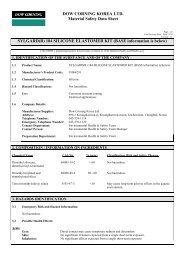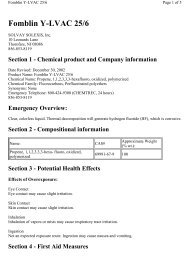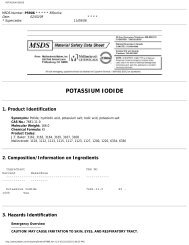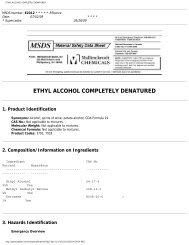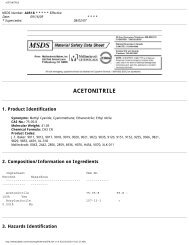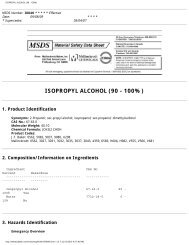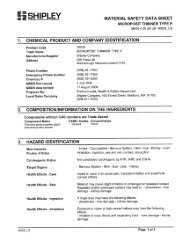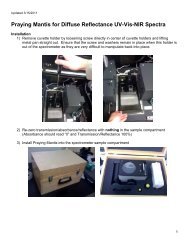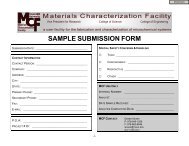ACETONE
ACETONE - Materials Characterization Facility
ACETONE - Materials Characterization Facility
- No tags were found...
Create successful ePaper yourself
Turn your PDF publications into a flip-book with our unique Google optimized e-Paper software.
<strong>ACETONE</strong><br />
MSDS Number: A0446 * * * * * Effective<br />
Date: 09/01/09 * * * *<br />
* Supercedes: 02/01/07<br />
<strong>ACETONE</strong><br />
1. Product Identification<br />
Synonyms: Dimethylketone; 2-propanone; dimethylketal<br />
CAS No.: 67-64-1<br />
Molecular Weight: 58.08<br />
Chemical Formula: (CH3)2CO<br />
Product Codes:<br />
J.T. Baker: 5008, 5018, 5356, 5580, 5965, 5975, 9001, 9002, 9003, 9004, 9005, 9006, 9007, 9008, 9009,<br />
9010, 9015, 9024, 9036, 9125, 9254, 9271, A134, V655<br />
Mallinckrodt: 0018, 2432, 2435, 2437, 2438, 2440, 2443, 2850, H451, H580, H981<br />
2. Composition/Information on Ingredients<br />
Ingredient<br />
CAS No<br />
Percent Hazardous<br />
--------------------------------------- ------------<br />
------------ ---------<br />
Acetone 67-64-1 99 -<br />
100% Yes<br />
3. Hazards Identification<br />
Emergency Overview<br />
--------------------------<br />
http://www.jtbaker.com/msds/englishhtml/a0446.htm (1 of 7) [2/12/2010 4:58:16 PM]
<strong>ACETONE</strong><br />
DANGER! EXTREMELY FLAMMABLE LIQUID AND VAPOR. VAPOR MAY CAUSE FLASH FIRE.<br />
HARMFUL IF SWALLOWED OR INHALED. CAUSES IRRITATION TO SKIN, EYES AND<br />
RESPIRATORY TRACT. AFFECTS CENTRAL NERVOUS SYSTEM.<br />
SAF-T-DATA (tm) Ratings (Provided here for your convenience)<br />
-----------------------------------------------------------------------------------------------------------<br />
Health Rating: 2 - Moderate<br />
Flammability Rating: 3 - Severe (Flammable)<br />
Reactivity Rating: 0 - None<br />
Contact Rating: 3 - Severe<br />
Lab Protective Equip: GOGGLES & SHIELD; LAB COAT & APRON; VENT HOOD; PROPER GLOVES; CLASS<br />
B EXTINGUISHER<br />
Storage Color Code: Red (Flammable)<br />
-----------------------------------------------------------------------------------------------------------<br />
Potential Health Effects<br />
----------------------------------<br />
Inhalation:<br />
Inhalation of vapors irritates the respiratory tract. May cause coughing, dizziness, dullness, and headache.<br />
Higher concentrations can produce central nervous system depression, narcosis, and unconsciousness.<br />
Ingestion:<br />
Swallowing small amounts is not likely to produce harmful effects. Ingestion of larger amounts may<br />
produce abdominal pain, nausea and vomiting. Aspiration into lungs can produce severe lung damage and is<br />
a medical emergency. Other symptoms are expected to parallel inhalation.<br />
Skin Contact:<br />
Irritating due to defatting action on skin. Causes redness, pain, drying and cracking of the skin.<br />
Eye Contact:<br />
Vapors are irritating to the eyes. Splashes may cause severe irritation, with stinging, tearing, redness and pain.<br />
Chronic Exposure:<br />
Prolonged or repeated skin contact may produce severe irritation or dermatitis.<br />
Aggravation of Pre-existing Conditions:<br />
Use of alcoholic beverages enhances toxic effects. Exposure may increase the toxic potential of<br />
chlorinated hydrocarbons, such as chloroform, trichloroethane.<br />
4. First Aid Measures<br />
Inhalation:<br />
Remove to fresh air. If not breathing, give artificial respiration. If breathing is difficult, give oxygen. Get<br />
medical attention.<br />
Ingestion:<br />
Aspiration hazard. If swallowed, vomiting may occur spontaneously, but DO NOT INDUCE. If vomiting occurs,<br />
keep head below hips to prevent aspiration into lungs. Never give anything by mouth to an unconscious<br />
person. Call a physician immediately.<br />
Skin Contact:<br />
Immediately flush skin with plenty of water for at least 15 minutes. Remove contaminated clothing and shoes.<br />
Get medical attention. Wash clothing before reuse. Thoroughly clean shoes before reuse.<br />
Eye Contact:<br />
Immediately flush eyes with plenty of water for at least 15 minutes, lifting upper and lower eyelids<br />
occasionally. Get medical attention.<br />
5. Fire Fighting Measures<br />
Fire:<br />
http://www.jtbaker.com/msds/englishhtml/a0446.htm (2 of 7) [2/12/2010 4:58:16 PM]
<strong>ACETONE</strong><br />
Flash point: -20C (-4F) CC<br />
Autoignition temperature: 465C (869F)<br />
Flammable limits in air % by volume:<br />
lel: 2.5; uel: 12.8<br />
Extremely Flammable Liquid and Vapor! Vapor may cause flash fire.<br />
Explosion:<br />
Above flash point, vapor-air mixtures are explosive within flammable limits noted above. Vapors can flow<br />
along surfaces to distant ignition source and flash back. Contact with strong oxidizers may cause fire.<br />
Sealed containers may rupture when heated. This material may produce a floating fire hazard. Sensitive to<br />
static discharge.<br />
Fire Extinguishing Media:<br />
Dry chemical, alcohol foam or carbon dioxide. Water may be ineffective. Water spray may be used to keep<br />
fire exposed containers cool, dilute spills to nonflammable mixtures, protect personnel attempting to stop leak<br />
and disperse vapors.<br />
Special Information:<br />
In the event of a fire, wear full protective clothing and NIOSH-approved self-contained breathing apparatus<br />
with full facepiece operated in the pressure demand or other positive pressure mode.<br />
6. Accidental Release Measures<br />
Ventilate area of leak or spill. Remove all sources of ignition. Wear appropriate personal protective equipment<br />
as specified in Section 8. Isolate hazard area. Keep unnecessary and unprotected personnel from entering.<br />
Contain and recover liquid when possible. Use non-sparking tools and equipment. Collect liquid in an<br />
appropriate container or absorb with an inert material (e. g., vermiculite, dry sand, earth), and place in a<br />
chemical waste container. Do not use combustible materials, such as saw dust. Do not flush to sewer! If a leak<br />
or spill has not ignited, use water spray to disperse the vapors, to protect personnel attempting to stop leak, and<br />
to flush spills away from exposures. US Regulations (CERCLA) require reporting spills and releases to soil,<br />
water and air in excess of reportable quantities. The toll free number for the US Coast Guard National<br />
Response Center is (800) 424-8802.<br />
J. T. Baker SOLUSORB® solvent adsorbent is recommended for spills of this product.<br />
7. Handling and Storage<br />
Protect against physical damage. Store in a cool, dry well-ventilated location, away from any area where the<br />
fire hazard may be acute. Outside or detached storage is preferred. Separate from incompatibles.<br />
Containers should be bonded and grounded for transfers to avoid static sparks. Storage and use areas should<br />
be No Smoking areas. Use non-sparking type tools and equipment, including explosion proof ventilation.<br />
Containers of this material may be hazardous when empty since they retain product residues (vapors,<br />
liquid); observe all warnings and precautions listed for the product.<br />
8. Exposure Controls/Personal Protection<br />
Airborne Exposure Limits:<br />
Acetone:<br />
-OSHA Permissible Exposure Limit (PEL): 1000 ppm (TWA)<br />
-ACGIH Threshold Limit Value (TLV): 500 ppm (TWA),<br />
750 ppm (STEL) A4 - not classifiable as a human carcinogen<br />
Ventilation System:<br />
A system of local and/or general exhaust is recommended to keep employee exposures below the<br />
Airborne Exposure Limits. Local exhaust ventilation is generally preferred because it can control the emissions<br />
http://www.jtbaker.com/msds/englishhtml/a0446.htm (3 of 7) [2/12/2010 4:58:16 PM]
<strong>ACETONE</strong><br />
of the contaminant at its source, preventing dispersion of it into the general work area. Please refer to the<br />
ACGIH document, Industrial Ventilation,<br />
A Manual of<br />
Recommended Practices<br />
, most recent edition, for details.<br />
Personal Respirators (NIOSH Approved):<br />
If the exposure limit is exceeded and engineering controls are not feasible, a half-face organic vapor respirator<br />
may be worn for up to ten times the exposure limit, or the maximum use concentration specified by<br />
the appropriate regulatory agency or respirator supplier, whichever is lowest. A full-face piece organic<br />
vapor respirator may be worn up to 50 times the exposure limit, or the maximum use concentration specified<br />
by the appropriate regulatory agency or respirator supplier, whichever is lowest. For emergencies or<br />
instances where the exposure levels are not known, use a full-face piece positive-pressure, air-supplied<br />
respirator. WARNING: Air-purifying respirators do not protect workers in oxygen-deficient atmospheres.<br />
Skin Protection:<br />
Wear impervious protective clothing, including boots, gloves, lab coat, apron or coveralls, as appropriate,<br />
to prevent skin contact.<br />
Eye Protection:<br />
Use chemical safety goggles and/or a full face shield where splashing is possible. Maintain eye wash fountain<br />
and quick-drench facilities in work area.<br />
9. Physical and Chemical Properties<br />
Appearance:<br />
Clear, colorless, volatile liquid.<br />
Odor:<br />
Fragrant, mint-like<br />
Solubility:<br />
Miscible in all proportions in water.<br />
Specific Gravity:<br />
0.79 @ 20C/4C<br />
pH:<br />
No information found.<br />
% Volatiles by volume @ 21C (70F):<br />
100<br />
Boiling Point:<br />
56.5C (133F) @ 760 mm Hg<br />
Melting Point:<br />
-95C (-139F)<br />
Vapor Density (Air=1):<br />
2.0<br />
Vapor Pressure (mm Hg):<br />
400 @ 39.5C (104F)<br />
Evaporation Rate (BuAc=1):<br />
ca. 7.7<br />
10. Stability and Reactivity<br />
Stability:<br />
Stable under ordinary conditions of use and storage.<br />
Hazardous Decomposition Products:<br />
Carbon dioxide and carbon monoxide may form when heated to decomposition.<br />
Hazardous Polymerization:<br />
Will not occur.<br />
Incompatibilities:<br />
Concentrated nitric and sulfuric acid mixtures, oxidizing materials, chloroform, alkalis, chlorine compounds,<br />
http://www.jtbaker.com/msds/englishhtml/a0446.htm (4 of 7) [2/12/2010 4:58:16 PM]
<strong>ACETONE</strong><br />
acids, potassium t-butoxide.<br />
Conditions to Avoid:<br />
Heat, flames, ignition sources and incompatibles.<br />
11. Toxicological Information<br />
Oral rat LD50: 5800 mg/kg; Inhalation rat LC50: 50,100mg/m3; Irritation eye rabbit, Standard Draize, 20<br />
mg severe; investigated as a tumorigen, mutagen, reproductive effector.<br />
--------\Cancer Lists\------------------------------------------------------<br />
---NTP Carcinogen---<br />
Ingredient Known Anticipated IARC Category<br />
------------------------------------ ----- ----------- -------------<br />
Acetone (67-64-1) No No None<br />
12. Ecological Information<br />
Environmental Fate:<br />
When released into the soil, this material is expected to readily biodegrade. When released into the soil,<br />
this material is expected to leach into groundwater. When released into the soil, this material is expected to<br />
quickly evaporate. When released into water, this material is expected to readily biodegrade. When released<br />
to water, this material is expected to quickly evaporate. This material has a log octanol-water partition<br />
coefficient of less than 3.0. This material is not expected to significantly bioaccumulate. When released into the<br />
air, this material may be moderately degraded by reaction with photochemically produced hydroxyl radicals.<br />
When released into the air, this material may be moderately degraded by photolysis. When released into the<br />
air, this material is expected to be readily removed from the atmosphere by wet deposition.<br />
Environmental Toxicity:<br />
This material is not expected to be toxic to aquatic life. The LC50/96-hour values for fish are over 100 mg/l.<br />
13. Disposal Considerations<br />
Whatever cannot be saved for recovery or recycling should be handled as hazardous waste and sent to a<br />
RCRA approved incinerator or disposed in a RCRA approved waste facility. Processing, use or contamination of<br />
this product may change the waste management options. State and local disposal regulations may differ<br />
from federal disposal regulations. Dispose of container and unused contents in accordance with federal, state<br />
and local requirements.<br />
14. Transport Information<br />
Domestic (Land, D.O.T.)<br />
-----------------------<br />
Proper Shipping Name: <strong>ACETONE</strong><br />
Hazard Class: 3<br />
UN/NA: UN1090<br />
Packing Group: II<br />
Information reported for product/size: 188L<br />
International (Water, I.M.O.)<br />
http://www.jtbaker.com/msds/englishhtml/a0446.htm (5 of 7) [2/12/2010 4:58:16 PM]
<strong>ACETONE</strong><br />
-----------------------------<br />
Proper Shipping Name: <strong>ACETONE</strong><br />
Hazard Class: 3<br />
UN/NA: UN1090<br />
Packing Group: II<br />
Information reported for product/size: 188L<br />
15. Regulatory Information<br />
--------\Chemical Inventory Status - Part 1\---------------------------------<br />
Ingredient TSCA EC Japan Australia<br />
----------------------------------------------- ---- --- ----- ---------<br />
Acetone (67-64-1)<br />
Yes Yes<br />
Yes Yes<br />
--------\Chemical Inventory Status - Part 2\---------------------------------<br />
--Canada--<br />
Ingredient Korea DSL NDSL Phil.<br />
----------------------------------------------- ----- --- ---- -----<br />
Acetone (67-64-1) Yes Yes No Yes<br />
--------\Federal, State & International Regulations - Part 1\----------------<br />
-SARA 302- ------SARA 313------<br />
Ingredient RQ TPQ List Chemical Catg.<br />
----------------------------------------- --- ----- ---- --------------<br />
Acetone (67-64-1) No No Yes No<br />
--------\Federal, State & International Regulations - Part 2\----------------<br />
-RCRA- -TSCA-<br />
Ingredient CERCLA 261.33 8(d)<br />
----------------------------------------- ------ ------ ------<br />
Acetone (67-64-1) 5000<br />
U002 No<br />
Chemical Weapons Convention: No TSCA 12(b): No CDTA: Yes<br />
SARA 311/312: Acute: Yes Chronic: No Fire: Yes Pressure: No<br />
Reactivity: No<br />
(Pure / Liquid)<br />
Australian Hazchem Code: 2[Y]E<br />
Poison Schedule: None allocated.<br />
WHMIS:<br />
This MSDS has been prepared according to the hazard criteria of the Controlled Products Regulations (CPR)<br />
and the MSDS contains all of the information required by the CPR.<br />
16. Other Information<br />
NFPA Ratings: Health: 1 Flammability: 3 Reactivity: 0<br />
Label Hazard Warning:<br />
DANGER! EXTREMELY FLAMMABLE LIQUID AND VAPOR. VAPOR MAY CAUSE FLASH FIRE. HARMFUL<br />
IF SWALLOWED OR INHALED. CAUSES IRRITATION TO SKIN, EYES AND RESPIRATORY TRACT.<br />
http://www.jtbaker.com/msds/englishhtml/a0446.htm (6 of 7) [2/12/2010 4:58:16 PM]
<strong>ACETONE</strong><br />
AFFECTS CENTRAL NERVOUS SYSTEM.<br />
Label Precautions:<br />
Keep away from heat, sparks and flame.<br />
Keep container closed.<br />
Use only with adequate ventilation.<br />
Wash thoroughly after handling.<br />
Avoid breathing vapor.<br />
Avoid contact with eyes, skin and clothing.<br />
Label First Aid:<br />
Aspiration hazard. If swallowed, vomiting may occur spontaneously, but DO NOT INDUCE. If vomiting occurs,<br />
keep head below hips to prevent aspiration into lungs. Never give anything by mouth to an unconscious<br />
person. Call a physician immediately. If inhaled, remove to fresh air. If not breathing, give artificial respiration.<br />
If breathing is difficult, give oxygen. In case of contact, immediately flush eyes or skin with plenty of water for<br />
at least 15 minutes. Remove contaminated clothing and shoes. Wash clothing before reuse. In all cases,<br />
get medical attention.<br />
Product Use:<br />
Laboratory Reagent.<br />
Revision Information:<br />
No Changes.<br />
Disclaimer:<br />
************************************************************************************************<br />
Mallinckrodt Baker, Inc. provides the information contained herein in good faith but makes<br />
no representation as to its comprehensiveness or accuracy. This document is intended only as a<br />
guide to the appropriate precautionary handling of the material by a properly trained person<br />
using this product. Individuals receiving the information must exercise their independent<br />
judgment in determining its appropriateness for a particular purpose. MALLINCKRODT BAKER,<br />
INC. MAKES NO REPRESENTATIONS OR WARRANTIES, EITHER EXPRESS OR IMPLIED,<br />
INCLUDING WITHOUT LIMITATION ANY WARRANTIES OF MERCHANTABILITY, FITNESS FOR<br />
A PARTICULAR PURPOSE WITH RESPECT TO THE INFORMATION SET FORTH HEREIN OR<br />
THE PRODUCT TO WHICH THE INFORMATION REFERS. ACCORDINGLY, MALLINCKRODT BAKER,<br />
INC. WILL NOT BE RESPONSIBLE FOR DAMAGES RESULTING FROM USE OF OR RELIANCE UPON<br />
THIS INFORMATION.<br />
************************************************************************************************<br />
Prepared by: Environmental Health & Safety<br />
Phone Number: (314) 654-1600 (U.S.A.)<br />
http://www.jtbaker.com/msds/englishhtml/a0446.htm (7 of 7) [2/12/2010 4:58:16 PM]



